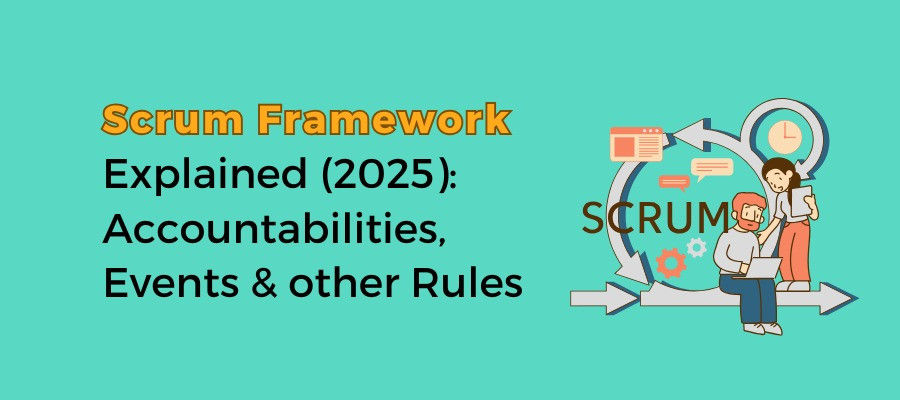Scrum Framework Explained (2025): Accountabilities, Events & other Rules

The Scrum framework has become the most practiced Agile framework worldwide. According to the 17th Annual State of Agile Report, nearly 70% of Agile teams use Scrum or a hybrid of Scrum. Teams prefer it because it provides structure without being too prescriptive. The framework thrives in complex environments where requirements change often and customer needs evolve quickly.
Scrum is built on short iterations, constant feedback, and collaborative work. This makes it adaptable to modern business demands. While it began in software development, Scrum methodology is now used by marketing teams, HR departments, and even government agencies.
While Scrum dominates Agile adoption globally, it is just one of several popular Agile frameworks. If you want to compare Scrum with Kanban, Lean, SAFe, and others, explore our comprehensive overview of Top 7 Agile Frameworks in 2025 written by Certified Scrum Trainer Suresh Konduru
Scrum Principles & Values

- Focus – Scrum teams concentrate on the defined sprint backlog and the goals agreed upon during sprint planning. This focus reduces distractions and ensures that the highest-value work receives attention first. Research from VersionOne’s State of Agile Report (2023) shows that teams with clear sprint focus achieve 28% faster delivery cycles.
- Courage – Members of the team demonstrate courage by raising risks early, questioning ineffective practices, and experimenting with innovative approaches. Courage allows teams to respond quickly to changing customer needs and market conditions.
- Openness – Transparency is a cornerstone of Scrum methodology. Teams share progress, obstacles, and learnings openly during events such as daily Scrums and sprint reviews. This openness ensures that stakeholders have real-time visibility into the work.
- Respect – Scrum recognizes that cross-functional teams require diverse skills and viewpoints. Respect means valuing every contribution, which in turn builds stronger trust and smoother collaboration across roles such as developers, product owners, and Scrum Masters.
- Commitment – Teams commit to delivering outcomes that match the sprint goal and the definition of done. This commitment strengthens accountability and makes stakeholders more confident in project outcomes.

- Product Owner (PO)
- Scrum Master (SM)
- Developers
Events:
- Sprint – A time-boxed iteration of one to four weeks where value is delivered. Most teams in 2025 favor two-week sprints for faster feedback.
- Sprint Planning – The team defines the Sprint Goal, selects backlog items, and creates an execution plan.
- Daily Scrum – A 15-minute daily scrum event where developers inspect progress toward the Sprint Goal and adjust the plan.
- Sprint Review – Stakeholders and the team inspect the increment, discuss feedback, and adapt the product backlog.
- Sprint Retrospective – The team reflects on processes, collaboration, and tools to improve in the next sprint.
Artifacts:
- Product Backlog – An evolving, ordered list of product improvements, features, and fixes that reflect customer and business needs.
- Sprint Backlog – The selected product backlog items plus a plan showing how the team will meet the Sprint Goal.
- Increment – The sum of all completed backlog items that meet the Definition of Done and are potentially shippable.
- High adaptability to evolving business needs through iterative delivery.
- Shorter release cycles that improve time-to-market and ROI.
- Strong collaboration and visibility across roles and stakeholders.
- Widely validated framework with global adoption and proven results.
- Built-in feedback loops that enhance product quality and customer satisfaction.
Limitations:
- Requires a cultural and mindset shift, not just new ceremonies.
- Breaks down if roles, values, or events are applied inconsistently.
- Most effective for small to medium-sized, cross-functional teams.
- Needs active sponsorship and alignment from leadership.
- Scaling to large enterprises may require additional frameworks like SAFe or LeSS.
- Jira Align – Scales Scrum across large enterprises.
- ClickUp – Flexible boards with AI-powered suggestions.
- Azure DevOps – Best for engineering-heavy teams.
- Notion – Combines docs with Scrum boards for smaller teams.
- Monday.com – Strong visualization for cross-department projects.
- Scrum remains the most practiced Agile framework, dominating 70% of Agile use cases.
- Success relies on understanding Scrum methodology, applying Scrum best practices, and respecting the Scrum roles.
- The framework works in any industry when leaders commit to its principles.
- In 2025, adoption will continue to expand beyond software into enterprise-wide transformations.
FAQs
1. What is the primary purpose of the Scrum framework?
It helps teams deliver value in small increments with continuous feedback and adaptation.
2. How many Scrum roles exist?
There are three defined roles: Product Owner, Scrum Master, and Developers.
3. Is Scrum methodology only for IT teams?
No. It is widely used in non-IT areas like HR, marketing, and finance.
4. What is the ideal sprint length?
Most teams use two-week sprints, but one to four weeks is allowed.
5. What are the Scrum best practices for new teams?
Start with small teams, hold regular retrospectives, and focus on delivering a working increment each sprint.




